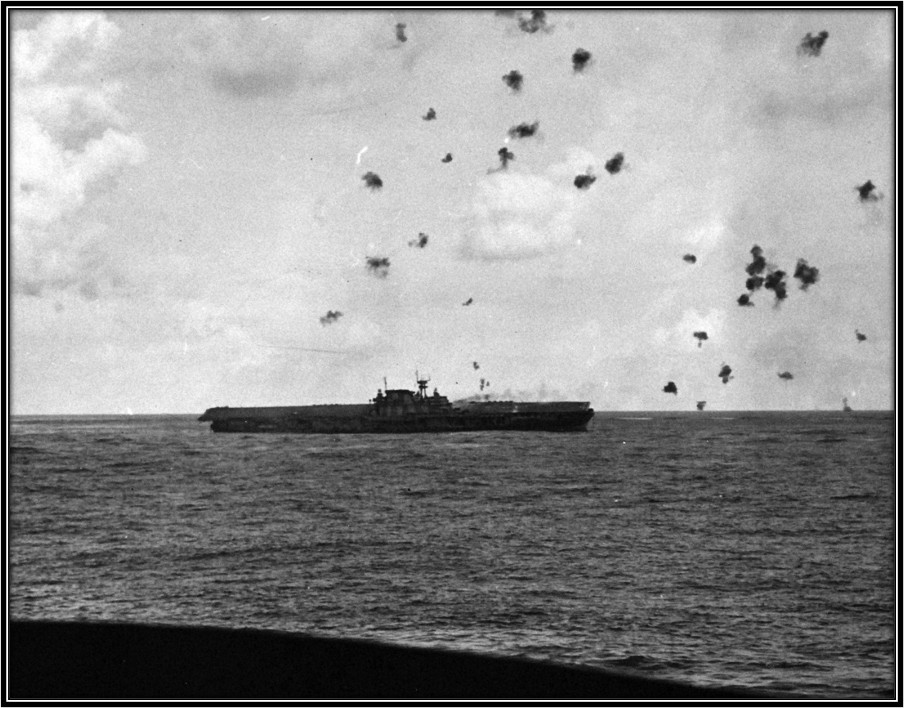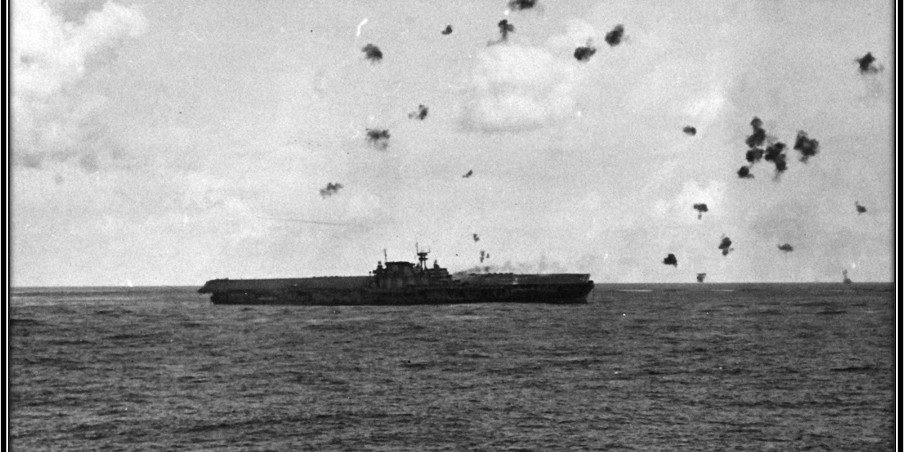When all hope seems lost
Contributor: Barry Fetzer
Sources: History.com, US Navy
The sinking of the iconic aircraft carrier, the USS Hornet, might have seemed to onlookers at the time as almost an irretrievable tragedy, beyond the loss of life.
Beyond hope, even. The Battle in which the USS Hornet was sunk was less than a year after the Japanese attack on Pearl Harbor.
But the loss of the USS Hornet is but one of many historical examples of loss that ultimately led to success. Pearl Harbor is also an example.
Here’s another. Our neighbor, Ted Ray, was a fire fighter burned so badly fighting an arson fire that he was retired medically from the Akron, Ohio fire service. He spent weeks in the hospital recovering but ultimately found joy and continued success here in the Sandhills as a good friend and neighbor to everyone, a golfer, and as a golf course jack-of-all-trades.
This idea of loss leading to success is tied to our physical, psychological, and spiritual lexicon, too.
“Scar tissue is stronger than regular tissue. Realize the strength, move on.” (Henry Rollins)
“Not until we are lost do we begin to understand ourselves.” (Henry David Thoreau)
“If you can’t control what’s happening to you, control how you respond. That’s where your power is.” (Unknown)
“Our greatest glory is not in never failing, but in rising every time we fall.” (Confucius)
“If you’re going through hell, keep going.” (Winston Churchill)
“Don’t dwell on what went wrong. Instead, focus on what to do next. Spend your energies on moving forward toward finding the answer.” (Denis Waitley)
“As long as you feel the pain, you’re still alive. And as long as you keep trying, there is still hope.” (Unknown)
“It’s only after we’ve lost everything that we’re free to do anything.” (Chuck Palahniuk)
“It is worth remembering that the time of greatest gain in terms of wisdom and inner strength is often that of greatest difficulty.” (Dalai Lama)
“We must accept finite disappointment, but never lose infinite hope.” (Martin Luther King Jr.)
“There is no such thing as a hopeless situation. Every single circumstance of your life can change.” (Ritu Ghatourey)
“We haven’t lost everything, if we haven’t lost our hope.” (Anonymous)
“Develop success from failures. Discouragement and failure are two of the surest stepping stones to success.” (Dale Carnegie)
“Only after disaster can we be resurrected.” (Chuck Palahniuk, Fight Club)
“We must be willing to let go of the life we’ve planned, so as to have the life that is waiting for us.” (Joseph Campbell)
“Your present circumstances don’t determine where you go; they merely determine where you start.” (Nido Qubein)
“Character is what you have left when you’ve lost everything you can lose.” (Unknown)
“I lost everything. I have found myself.” (Anonymous)
“You can never cross the ocean until you have the courage to lose sight of the shore.” (Christian Bales)
“Consider it a great joy, my brothers and sisters, whenever you experience various trials, because you know that the testing of your faith produces endurance. And let endurance have its full effect, so that you may be mature and complete, lacking nothing.” (King James Bible, James 1 ,2-4)
“We can trust Him with our pain, when all seems lost, because He does not abandon His own” (King James Bible, Psalm 9:10)
While, yes, the advice of those words is easier said than done, there is still great power in these words.
Japanese planes destroy the U.S.S. Hornet
By HISTORY.com Editors downloaded today from: https://www.history.com/this-day-in-history/october-26/the-united-states-loses-the-hornet
Published: November 05, 2009
Last Updated: October 23, 2025
On October 26, 1942, the last U.S. carrier manufactured before America’s entry into World War II, the Hornet, is damaged so extensively by Japanese war planes in the Battle of Santa Cruz that it was abandoned.
The battle for Guadalcanal was the first American offensive against the Japanese, an attempt to prevent the Axis power from taking yet another island in the Solomon chain and gaining more ground in its race for Australia. On this day, in the vicinity of the Santa Cruz Islands, two American naval task forces had to stop a superior Japanese fleet, which was on its way to Guadalcanal with reinforcements. As was the case in the Battle of the Coral Sea in May 1942, the engagement at Santa Cruz was fought exclusively by aircraft taking off from carriers of the respective forces; the ships themselves were not in range to fire at one another.
 Japanese aerial fire damaged the USS Enterprise, the battleship South Dakota, and finally the Hornet. In fact, the explosions wrought by the Japanese bombs that rained down on the Hornet were so great that two of the Japanese bombers were themselves crippled by the blasts, and the pilots chose to dive-bomb their planes into the deck of the American carrier, which was finally abandoned and left to burn. The Hornet, which weighed 20,000 tons, had seen battle during the Doolittle Raid on Tokyo (its commander at the time, Marc Mitscher, was promoted to admiral and would be a significant player in the victory over Japan) and the Battle of Midway.
Japanese aerial fire damaged the USS Enterprise, the battleship South Dakota, and finally the Hornet. In fact, the explosions wrought by the Japanese bombs that rained down on the Hornet were so great that two of the Japanese bombers were themselves crippled by the blasts, and the pilots chose to dive-bomb their planes into the deck of the American carrier, which was finally abandoned and left to burn. The Hornet, which weighed 20,000 tons, had seen battle during the Doolittle Raid on Tokyo (its commander at the time, Marc Mitscher, was promoted to admiral and would be a significant player in the victory over Japan) and the Battle of Midway.
Battle of Santa Cruz Islands, 26 October 1942. USS Hornet (CV 8) listing after the Japanese attack, she was abandoned at this point. Photographed from USS Pensacola (CA 24). U.S. Navy photograph, now in the collections of the National Archives.
While the United States losses at Santa Cruz were heavy, the cost in aircraft to the Japanese was so extensive—more than 100, including 25 of the 27 bombers that attacked the Hornet—that they were unable finally to reinforce their troops at Guadalcanal, paving the way for an American victory.
Onward and upward!
Sources: History.com, US Navy







